|
Mortal Kombat 3
|
Released 1995
Midway |
Platform: Arcade, PC, SNES, Genesis, Gameboy, Gamegear |
Genre: Fighting |
1 or 2 Players |
Rated: M |
|
Cast: Richard Divizio, Kerri Hoskins, John Parrish, Tony Marquez, Michael Obrien, John Turk, Lia Montelongo, Eddie Wong, Sal Divita, Brian Glynn.
|
|
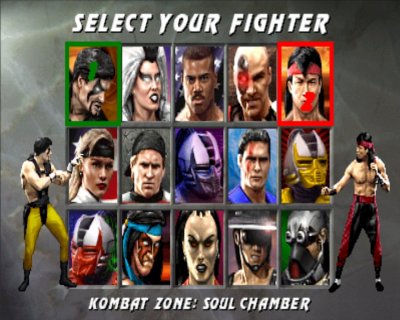
Many MK2 cast members got into trouble with Midway (Daniel and Carlos Pesina) or had royalty disputes with the company (Ho Sung Pak and Katalin Zamiar) which may have factored into their character’s absence.

Mortal Kombat 3 introduced a new Vs screen where you can input a code to get various effects such as Unlimited Run, Dark Kombat, and Blocking Disabled.
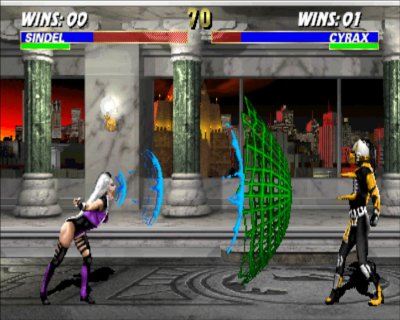
Not only do these two new characters bare a passing resemblance to missing MK2 combatants, but Sindel’s scream and Cyrax’s net function eerily similar to Kitana’s fan lift and Scorpion’s spear.
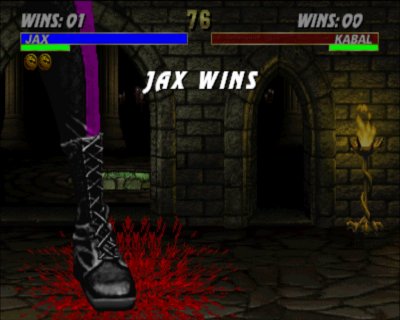
True, in Mortal Kombat 2 Liu Kang turns into a dragon. It’s over the top and silly, yes. But, you have to admit, a dragon is infinitely more interesting to look at than a frickin’ boot.
Review by Jay Wilson
05/07/2011
Like the previous two installments, I played MK3 religiously. But unlike Mortal Kombat 2 where I felt comfortable playing any character, and eventually came to use Shang Tsung so I could tap into all characters on a whim, with Mortal Kombat 3 I tended to gravitate towards Sub-Zero, Smoke, and Kabal. Sure, over time, I became acquainted with the entire cast, and I tried them each in turn. But I really had no desire to pick anyone outside my three usuals.
Half of the Mortal Kombat 2 characters did not return; most of the ones who came back didn’t sit right with me. New actors portrayed Liu Kang and Shang Tsung, and neither quite felt right gameplay wise (I can’t put my finger on if it was the new actors, slightly different hit boxes, the new flow of their moves, their crappy Fatalities, or a combination of all-of-the above.) Plus Tsung’s new design looked corny at best with yellow pants, face-paint, and whatever-the-hell that’s supposed to be on his torso. Tony Marquez and John Parrish reprise their roles as Kung Lao and Jax, but again, something didn’t quite feel right in their gameplay—they felt stilted compared to MK2, like they lost something along the way and didn’t really gain anything significant to make up for it. For example, both Jax and Kung Lao’s respective projectiles received overhauls that felt clumsy and ineffective compared to their old ones.
Strangely enough, the new (unmasked) Sub-Zero (now played by John Turk) I took to right away. He retaining his trademark freeze and slide but lost his ground-freeze; however, in its place he gained an ice-clone which freezes enemies who touch it, and an ice-shower where he shoots his ice ball into the top of the screen and it rains down on his opponent. Sub-Zero felt like he took the next step in his gameplay evolution where as Jax, Kung Lao, Liu Kang, and Shang Tsung felt like downgrades at worst and sidesteps at best.
Nightwolf struck me as a token stereotype with his face paint, tomahawk, and bow-and-arrow. Sindel? A watered down Kitana. Cyrax? A poor man’s Scorpion (in yellow, no less). The idea of playing as Sheeva, a four-armed Shokan (a la Goro and Kintaro), proved more interesting than actually playing her. Stryker, an ordinary guy, seemed bland juxtaposed to people who could generate fireballs and teleport. Kano and Sonya’s were fun for nostalgia sake, but otherwise didn’t do much for me (my two least favorites in the original MK). Which only leaves Sektor, whom I liked, but abandoned once Smoke became unlocked, and Kabal, a unique character with devastating combos and, sadly, the absolute worst Fatalities in a game of terrible Fatalities.
People often criticize MK3 for its more urban look and feel with battles taking place on city streets, graveyards, skyscraper interiors, rooftops, and cathedrals; however, I appreciate and welcome the venue change especially since it makes sense with the game’s underlying premise that Shao Kahn has invaded Earth. Also, a nice welcomed addition: in certain stages, a player may uppercut his opponent through the ceiling and onto another stage where the battle continues (the Subway leads to the Street; the Bank Interior leads to the rooftops; the Soul Chamber leads to the Chapel.)
The new combo system (dubbed “dial-a-combo” for its button tap nature) received mixed reviews. I personally think it’s a good example of why MK3 didn’t blow away its predecessor like MK2 did. It was different, but not necessarily better. Likewise the new “run” button was different, but it really didn’t add anything. Mortal Kombat 2 brought a whole new dimension to the fights and (more importantly) made them far more fun and interesting. Mortal Kombat 3 is simply “different” ... as if after MK2, Boon, Tobias, and crew didn’t know where to go.
Which brings me to the real downfall of Mortal Kombat 3—the entire point behind the Mortal Kombat franchise—the Fatalities. Wow, do they suck!
I’m guessing that in an effort to maximize the game’s content, the developers took shortcuts with the sprites and animations. For example, in Mortal Kombat 2 a severed head will roll and bounce, a severed torso will flip over as it falls through the air, and a decapitated body will fall to its knees and collapse—it uses a few extra sprites to create the illusion of post-mortem movement (not to mention basic physics) which creates a degree of verisimilitude. It’s a ridiculous over-the-top spectacle, but MK2 goes that extra bit to help you swallow the silliness. In MK3, a single static unmoving sprite gets cut and paste around the screen, and (as a result) the MK3 Fatalities are like watching a cardboard cutout getting rearranged. Severed body parts always remain right side up. No rolling on the ground nor flipping as they fly through the air. Decapitated bodies remain standing, and severed arms float in mid air. None of the Finishers have the uniqueness of, say, MK2’s Kung Lao Fatality where he splits them in half and we see the victim’s remains split like a banana peel (an animation unique to only that Fatality.)

Notice Nightwolf’s severed forearms just floating in the air as if the designers just cut and paste parts of a static sprite instead of having the actors create genuine animation.
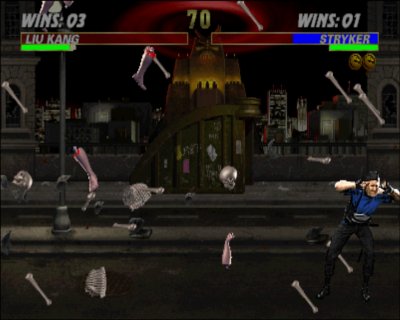
Apparently Liu Kang had two rib cages, two skulls, three feet, and nine femurs.

Check out the gore, the perspective, and level of detail on the MK1 spikes (right) versus the clean, repeating, carbon-copies of the MK3 spikes (left).
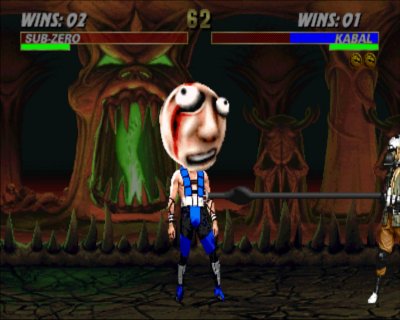
You have no idea how much I wish this were Photoshopped. This is an actual Fatality of one of the coolest, most powerful, characters in the game ... and no, Kabal’s 2nd Fatality isn’t any better.

Animalities must be performed in round 3 following a “Mercy”, a universal move that bestows a sliver of life back to your opponent. Beat them again, and now you may finish them with an Animality.

Even in stillshot, the MK2 dragon (left) looks like it has actually bit Tsung in half; the MK3 dragon (right) looks like it's just standing next to Tsung's bloody remains.
Beyond that, the number of Fatalities that hide behind generic sprites has drastically increased. Granted, the previous games had Scorpion burning up a generic skeleton which could belong to any character. But Mortal Kombat 3 almost comically draws attention to the number of Fatalities that rely on either a giant burst of blood (Jax’s stomp, Cyrax’s helicopter) or the infamous “mannequin explosions” (Stryker’s bomb, Cyrax’s bomb, Smoke’s bomb, Sonya’s Death Bubble, Kano’s eye-laser, Sektor’s compactor) or a flaming skeleton (Sonya’s Kiss of Death, Liu Kang’s vanishing inferno, Sektor’s flamethrower) or Nightwolf making a generic skeleton disappear in a shaft of light. Hell, in MK3, even the spikes at the bottom of Shao Kahn’s Tower look generically copy & pasted, lacking even the basic sense of perspective the MK1 pit possessed.
Looking past even that complaint, many of the MK3 Fatalities are just plain retarded such as Lui Kang dropping an MK1 cabinet on his victim; or (I kid you not) Kabal taking off his mask, screaming, and scaring the ghost out of his opponent; or Sindel wrapping her hair around her prey and spinning them like a top until there’s nothing left; or even Smoke dropping a few dozen bombs and blowing up Earth—yes, not only does he self-destruct (like a Cyrax Fatality), but he takes the whole effin’ planet with him.
Friendships mercifully return, giving many characters at least one amusing (not to mention unique) finisher (Kabal roasting marshmallows; Liu Kang’s shadow puppets). The retarded Babalities make a comeback and depressingly seem less stupid juxtaposed to the hideous Fatalities (the block letters announcing “Babality” was a nice touch.) Mortal Kombat 3 introduces a new underwhelming finishing move, the Animality, where the character turns into a colorful cartoony animal that, more often than not, doesn’t appear to do anything to their victim. Take, for example, Kano’s Animality. He turns into a giant spider, crawls up on his prey, and ... supposedly crushes the life out of them. However, 1.) the Spider and the victim look so vastly different, you can’t suspend your disbelief enough to accept them occupying the same space. And 2.) The victim looks totally fine (unconscious, but fine). No missing body parts, no fountain of blood, no explosion. The spider gives ‘em a hug, and they fall over.
And there is a curiosity here too: Liu Kang’s Animality is actually his Dragon Fatality from MK2, so one can watch them back to back and make some observations. First, the dragon doesn’t look as good as it used to due to the inexplicable aura and cartoony tint. Second, the dragon appears bigger in MK2 (it's actually smaller when you look at the screenshots side by side). But when you see the MK2 Fatality in action, the dragon slowly rises up like a snake getting ready to strike, and the lifebars disappear to make room for the beast. In MK3, it remains coiled (so to speak) so you never see it at its full height (hence the deceptive psychological impression). Third, in Mortal Kombat 2 the dragon actually looks like it bites its victim in half; in MK3, since the creature does not rise up it doesn’t have the same trajectory (nor positioning) to get its jaws around its prey. Thus, the animation lacks the same punch as the MK2 dragon. Fourth, in MK2, the arms have been consumed with the torso. In MK3? They’re floating in the air next to the the standing waist/legs.
Gone seem to be all those subtle touches that made Mortal Kombat 2 memorable—the blood that drips from the word “Fatality” and lands on the floor; after the Dead Pool Fatality, holding down+LP+LK to get the extra “aww maa” voice; holding down on both joysticks to get the corpse to slide off the Kombat Tomb’s ceiling spikes; the ability to extend Cage and Scorpion’s Fatalities; Shang Tsung having a 3rd Fatality where he morphs into an unplayable sub-boss. In MK3? We get different colored blood depending on whether the character in question is human, Shokan, or cyborg. “Yippee.”
Mortal Kombat 3 has opted for more standardized/streamlined “Kombat Kodes” to access the returning hidden character, Noob Saibot (who, btw, was lame in MK2—lazily named after MK’s co-creators Boon/Tobias—and somehow he gets even lamer in MK3.) Anyone can input the code to fight him. But with MK2, accessing the hidden fights felt more like an accomplishment—in MK2, you had to win 50 consecutive matches to fight Noob Saibot. To fight Smoke, not only did you have to know the stage to hit down+Start, but you had to actually pull it off mid-fight while the “Toasty” guy was on screen. Not everyone could climb the single player ladder of opponents, and fewer still could win the correct battle with only LK to face Jade. Mortal Kombat 3? Just tap on LK, BLK, and LP a few times, and you’re there.
Even the hidden playable character, Smoke, is unlocked via code (a special 10 digit “Ultimate Kombat Kode”). However, once entered, Smoke remains playable for anyone—even those who never touched the franchise before. It makes the full extent of the game available to more players, granted, but at the price of the mystique that made MK2 so enticing. With MK2, it truly felt like the more you played, the more you were rewarded for your time and energy with various little tidbits on top of the trademark finishers.
Anyway, the bosses ... while I applaud MK3 for taking a different route with the sub-boss—no more four-armed shokan—now we get a giant centaur. Change of pace, very different. I like it. I do, however, have one bone to pick with Motaro: his arbitary immunity to projectiles. Granted, he’s a huge target, which projectiles wouldn’t have any trouble hitting normally; however, consider this: Motaro has his own projectile which he can actually shoot rapidly enough to juggle his opponents with from across the screen. Motaro also has a teleport, so he could literally disappear safely from your fireball’s trajectory and reappear behind the player for guaranteed punishment. Not to mention, being a boss, he gets more damage, his sheer size gives him greater range (his tail sweep in particular), and his four legs make him harder to knock down (forget about sweeping him) ... why does he need absolute immunity from projectiles?
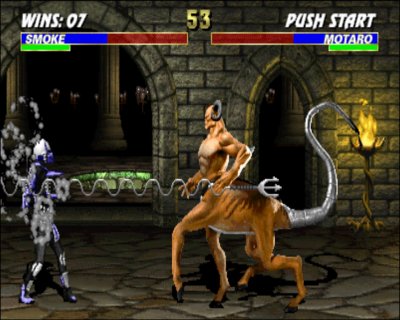
Notice Smoke’s harpoon in the middle of Motaro’s hide, and how it has absolutely no effect on him. Smoke actually gets off easy, though. Most projectiles actually bounce off Motaro.

Due to his larger sprite, in MK2 you could actually lock down Kahn with perpetual jump kicks, and the chip damage would eventually kill him. Thus, they gave him this anti-air rising knee in MK3.
After Motaro falls, it’s on to Shao Kahn once again who retains most of his MK2 attacks; he trades in his slow spear for a faster projectile (a green glowy glorified spitball), and he picks up a few new tricks (a rising knee and a sledgehammer.) However, if Kahn presents any kind of challenge, it’s due to his button reading AI which never fails to fire off his (faster) projectile any time you try to use your’s, or nail you out of the air as you go to jump .
Despite all my criticisms, I don’t think Mortal Kombat 3 is necessarily bad. At the time, I played the hell out of it, and even today I do enjoy the updated Ultimate Mortal Kombat 3. However, I do think it made three crippling miscalulations which prevented it from taking the next step it should have. 1. It dropped way too many characters (popular and iconic characters, no less.) 2. It went way too far squeezing the memory with generic animation/sprites. And 3. The Fatalities packed absolutely no punch.
And, really, why does anyone play Mortal Kombat?
|